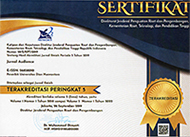The Migration from Analog to Digital Television
DOI:
https://doi.org/10.33633/ja.v5i2.7391Abstract
This study aims to see the effect of information exposure in the mass media and the level of public knowledge about digital television on people's decision making to adopt digital television. Digitization of television in Indonesia has been prepared more than 12 years ago. In 2009 Indonesia had prepared a framework for the implementation of a digital broadcasting system which was later in 2010. However, the migration process for digital television in Indonesia did not go well because of the conflict of interest of private television and regulations that were not yet strong. The theory of diffusion of innovation from Everett M. Rogers is used to provide an explanation of the pattern of adoption of new technologies in society. This quantitative study will measure the effect of exposure to digital television information and the level of public knowledge as independent variables and decision-making to adopt technology as the dependent variable. In this study, 120 respondents were selected based on the slovin formula with the number of families in Central Java as the population.. As a result, the effect of these variables is not significant. Digital television migration policy is a priority policy with authority innovation desicions. It stated in the UU Cipta Kerja which states that Indonesia must immediately switch analogue switched off a maximum of two years. So that the readiness and knowledge of the community will not affect the decision to adopt digital television or not.Keywords: Diffusion of Innovation; Digital Television Migration; Public ReadinessDownloads
Published
2023-02-23
Issue
Section
Articles
License
Authors who publish with this journal agree to the following terms:
- Authors retain copyright and grant the journal right of first publication with the work simultaneously licensed under a Creative Commons Attribution License that allows others to share the work with an acknowledgment of the work's authorship and initial publication in this journal.
- Authors are able to enter into separate, additional contractual arrangements for the non-exclusive distribution of the journal's published version of the work (e.g., post it to an institutional repository or publish it in a book), with an acknowledgment of its initial publication in this journal.
- Authors are permitted and encouraged to post their work online (e.g., in institutional repositories or on their website) prior to and during the submission process, as it can lead to productive exchanges, as well as earlier and greater citation of published work (See The Effect of Open Access).





















